Rescues / In the News
All of our instructors are rescue technicians with their home agencies so we are well connected with the active rescue community. The following accounts are of actual rescues performed by members of our instructor cadre as well as former students of the Peak Rescue Institute. These are just a few of the reasons why we dedicate ourselves to teaching the art and science of rope rescue.
MAR. 26, 2021: MAN RESCUEd AFTER FALL INTO CLASS 5 RAPIDS IN THE JOINER BROOK, BOLTON, VT
STOWE MTN. RESCUE, COLCHESTER TECHNICAL RESCUE, BOLTON F.D., RICHMOND F.D.
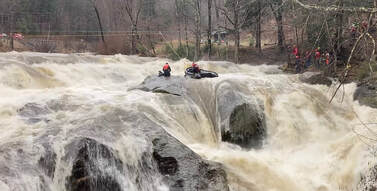
On Mar. 26th at 1341, Colchester Technical Rescue and Stowe Mountain Rescue were dispatched to a call for a 30 y.o. man stranded on a rock in the middle of the Joiner Brook. The brook was running fast and high after significant rain and snow melt. The man had jumped into the swollen brook in an attempt to rescue his dog who had been swept away. He too was immediately swept approximately 100' down river and ended up on a large boulder a short distance above a gorge. Temperatures were right around the freezing mark and there was steady rain.
A dual-track, tensioned highline was rigged approximately 150' across the brook. Left and right control lines allowed the shore-based rigging team to move the boat into position and the subject was moved from the rock into the boat. The subject was transported to the University of Vermont Medical Center for treatment of hypothermia. Click here for the WCAX news report.
Peak Rescue alumini participating on this call included Chip Perry, P.J. Aumand, Drew Clymer, Graham Govoni, Greg Speer, Andy Millick, Todd Westervelt, . Other responding agencies included Richmond F.D., Bolton F.D., Richmond Rescue.
(Photo: Courtesy of Paul Howard)
A dual-track, tensioned highline was rigged approximately 150' across the brook. Left and right control lines allowed the shore-based rigging team to move the boat into position and the subject was moved from the rock into the boat. The subject was transported to the University of Vermont Medical Center for treatment of hypothermia. Click here for the WCAX news report.
Peak Rescue alumini participating on this call included Chip Perry, P.J. Aumand, Drew Clymer, Graham Govoni, Greg Speer, Andy Millick, Todd Westervelt, . Other responding agencies included Richmond F.D., Bolton F.D., Richmond Rescue.
(Photo: Courtesy of Paul Howard)
AUG. 7, 2019: MAN RESCUEd AFTER 100' FALL ON HELL BROOK TRAIL, MT. MANSFIELD, VT
STOWE MTN. RESCUE, COLCHESTER TECHNICAL RESCUE
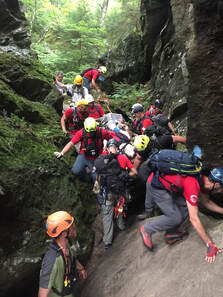
On Aug. 7th at 1234, Colchester Technical Rescue was dispatched to assist Stowe Mountain Rescue for a 59 y.o. man who was hiking on the Hell Brook trail on Mt. Mansfield with his wife and daughter. At approximately 3100′ they lost the trail. They continued up a steep slab and gully, where the subject lost his footing and fell approximately 100′, sliding, rolling and bouncing, landing in a shallow gully where he sustained serious injuries. His wife called 911 for assistance.
Cloud cover and thunder storm forecasts prevented any helicopter support and the 200′ in elevation drop below Hell Brook Cutoff prevented egress in that direction, requiring a difficult litter evacuation down the Hell Brook Trail.
The 250+ lbs. patient was packaged in a litter and was slowly moved down class 3 & 4 terrain utilizing numerous lowering systems for the vast majority of the way. Although the distance from the patient to the trailhead was just under a mile, the change in elevation was approximately 1400' over some steep, challenging technical sections. Tenuous weather added to the difficulty of this rescue. The patient was administered pain medications during the descent to aid in his comfort.
Peak Rescue alumini participating in this call included Drew Clymer, Graham Govoni, Chip Perry, Andrew Ruschp, Nick Warren and Peak Rescue instructor Matt Speier. Other responding agencies included Stowe Rescue, Waterbury Backcountry Rescue, Camel’s Hump Back-Country Rescue, Cambridge Rescue, Cambridge Fire.
(Photo: Courtesy of Matt Speier)
Cloud cover and thunder storm forecasts prevented any helicopter support and the 200′ in elevation drop below Hell Brook Cutoff prevented egress in that direction, requiring a difficult litter evacuation down the Hell Brook Trail.
The 250+ lbs. patient was packaged in a litter and was slowly moved down class 3 & 4 terrain utilizing numerous lowering systems for the vast majority of the way. Although the distance from the patient to the trailhead was just under a mile, the change in elevation was approximately 1400' over some steep, challenging technical sections. Tenuous weather added to the difficulty of this rescue. The patient was administered pain medications during the descent to aid in his comfort.
Peak Rescue alumini participating in this call included Drew Clymer, Graham Govoni, Chip Perry, Andrew Ruschp, Nick Warren and Peak Rescue instructor Matt Speier. Other responding agencies included Stowe Rescue, Waterbury Backcountry Rescue, Camel’s Hump Back-Country Rescue, Cambridge Rescue, Cambridge Fire.
(Photo: Courtesy of Matt Speier)
JUN. 10, 2019: MAN RESCUEd FROM CRATER LAKE CALDERA, CRATER LAKE NATIONAL PARK, OR
JACKSON COUNTY FIRE DISTRICT #3
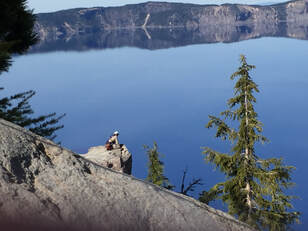
On June 10th at 1300, members of Jackson County Fire District 3 Tech Rescue Team were dispatched for mutual aid to Crater Lake National Park for a tourist who had fallen/slid approximately 1000‘ on a snow covered slope towards the water’s edge of the Crater Lake caldera.
JCFD were requested to set up a Two Tension Rope System (TTRS) with the objective of lowering a member on both lines, pick up the park ranger who had rappelled down to the end of her 600’ rope, and lower both to the area where the victim might be located. Attempts to reach the victim with voice commands were only successful after being lowered approximately 1000'. JCFD deployed a drone in an attempt to get eyes on the victim but were unsuccessful as he had maneuvered himself under the tree canopy and the radio link between the drone and controller had deteriorated due to flying below grade into the caldera.
The team had many knot passes to accomplish through the MPD’s and change of direction pulleys. They also determined early on that they did not possess enough rope to fill both lines 1 and 2. A decision was made by JCFD Battalion Chief / Peak Rescue Instructor Mike Calhoun, to operate line 1 with Park Service 11mm rope and appropriate MPD, and use JCFD's 12.5mm rope and MPD for line 2. All told, BC Calhoun and FF / Peak Rescue Instructor Don Manning lowered 1600’ of rope through each of the MPD’s and completed 28 knot passes (accounting for the change of direction pulley knot passes as well) and exhausted all of their department ropes longer than 100’.
The victim was located sitting under some trees approximately 250’ from the water line. He was cold, wet, and had a significant upper arm injury and complained of head pain. He slid about 1600’ on his back, head first. A USCG Dolphin helicopter arrived on scene for a rescue at 6500' elevation. A basket was lowered and Peak alum Patrick Bailey placed the victim into the basket for hoist. The helo lifted the victim back up to the lake rim road and handed him off to a Life Flight helo crew for transport to a hospital in Bend, Oregon. Patrick and the ranger with him then reattached to the TTRS and were hauled 1600’ back up to the edge and safely recovered.
Peak alum on scene were Instructors Don Manning and Mike Calhoun, and former students Will Clelland, Pat Haynes, and Patrick Bailey. Other agencies on scene included the National Park Service, US Coast Guard and AirLink Critical Care Transport.
Click here to read the article.
JCFD were requested to set up a Two Tension Rope System (TTRS) with the objective of lowering a member on both lines, pick up the park ranger who had rappelled down to the end of her 600’ rope, and lower both to the area where the victim might be located. Attempts to reach the victim with voice commands were only successful after being lowered approximately 1000'. JCFD deployed a drone in an attempt to get eyes on the victim but were unsuccessful as he had maneuvered himself under the tree canopy and the radio link between the drone and controller had deteriorated due to flying below grade into the caldera.
The team had many knot passes to accomplish through the MPD’s and change of direction pulleys. They also determined early on that they did not possess enough rope to fill both lines 1 and 2. A decision was made by JCFD Battalion Chief / Peak Rescue Instructor Mike Calhoun, to operate line 1 with Park Service 11mm rope and appropriate MPD, and use JCFD's 12.5mm rope and MPD for line 2. All told, BC Calhoun and FF / Peak Rescue Instructor Don Manning lowered 1600’ of rope through each of the MPD’s and completed 28 knot passes (accounting for the change of direction pulley knot passes as well) and exhausted all of their department ropes longer than 100’.
The victim was located sitting under some trees approximately 250’ from the water line. He was cold, wet, and had a significant upper arm injury and complained of head pain. He slid about 1600’ on his back, head first. A USCG Dolphin helicopter arrived on scene for a rescue at 6500' elevation. A basket was lowered and Peak alum Patrick Bailey placed the victim into the basket for hoist. The helo lifted the victim back up to the lake rim road and handed him off to a Life Flight helo crew for transport to a hospital in Bend, Oregon. Patrick and the ranger with him then reattached to the TTRS and were hauled 1600’ back up to the edge and safely recovered.
Peak alum on scene were Instructors Don Manning and Mike Calhoun, and former students Will Clelland, Pat Haynes, and Patrick Bailey. Other agencies on scene included the National Park Service, US Coast Guard and AirLink Critical Care Transport.
Click here to read the article.
FEB. 13, 2019: FRANK CARUS, SNOW RANGER ON NEW HAMPSHIRE PUBLIC RADIO, MT. WASHINGTON, NH
MT. WASHINGTON SNOW RANGERS
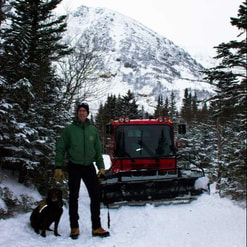
On February 13th, New Hampshire Public Radio aired an interview with Frank Carus, Avalanche Forecaster / Snow Ranger at the Mount Washington Avalanche Center (and Peak Rescue Instructor). Frank is the Lead Snow Rangers at the only avalanche center in the East and one of only two avalanche centers that also performs rescues. Also mentioned in the interview is Peak Rescue alumni Helon Hoffer. Listen to the interview here or click here to read the article.
(Photo: Courtesy of Sean Hurley)
(Photo: Courtesy of Sean Hurley)
JUL. 17, 2018: RIVER RESCUE ON THE DESCHUTES RIVER, YELM, WA
THURSTON COUNTY SORT
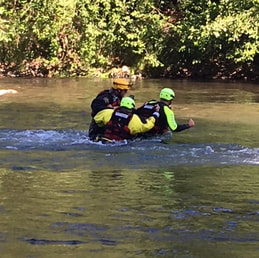
On the morning of July 17th, Thurston County SORT Team members (and Peak Rescue alumni and staff) BC Andy Speier, Pat Harn and Lt. Jon Winkleman were on their way to conduct rope rescue training for the Thurston County Dive Team at Deschutes Falls County Park. As they were driving thru Yelm, WA with a couple of Dive Team members, S.E. Thurston Fire & Rescue was dispatched to a water rescue on the Deschutes River. The crew responded with an 8 minute response time to the scene. Upon arrival S.E. Thurston Fire Authority learned that a woman in her 20's had been out floating the river when she become separated from her group. She spent the night along the river and was seen walking upstream on the farside bank by a fisherman who called 911.
Rescuers donned appropriate PPE and a group of three performed a shallow water crossing bringing a PFD for the victim. She was accessed, fitted for a PFD and drug across the river in her inner tube. Upon being brought ashore she was wrapped in blankets and evaluated by the EMS crew from Aid 21.
Rescuers donned appropriate PPE and a group of three performed a shallow water crossing bringing a PFD for the victim. She was accessed, fitted for a PFD and drug across the river in her inner tube. Upon being brought ashore she was wrapped in blankets and evaluated by the EMS crew from Aid 21.
JUL. 20, 2018: HIKER RESCUED FROM 40' FALL OFF RATTLESNAKE LEDGE, NORTH BEND, WA
EASTSIDE FIRE & RESCUE
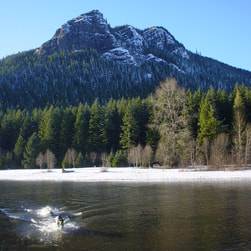
On July 20 at 2245, Eastside Fire & Rescue was dispatched to Rattlesnake Ledge to rescue a hiker who fell 40' off the east facing summit ledge. King County Sheriff's Office Guardian 1 helicopter was called in to assist in locating the fallen hiker who sustained significant back and leg trauma. Additional responding agencies included King County SAR and Bellevue Medics. Peak Rescue alumnus Capt. Pete Brummel was on the scene and served as the rescue group supervisor. Rattlesnake Ledge is a location that has seen numerous fatalities over the last nine years. Click here for the news report and video.
JUN. 28, 2018: woman rescued AFTER 100' FALL, TOKOTEE FALLS, OR
DOUGLAS COUNTY FIRE DISTRICT 2
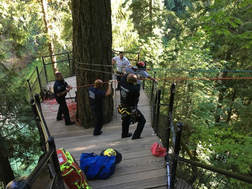
On June 28 at 1520, Douglas County Fire District 2 was dispatched for a report of a woman who fell 100' near Tokotee Falls after she went beyond the safety fencing to go for a hike.
Peak Rescue alumni on the scene included Josh Waecther, Mark Hernandez and Phil Hyatt . Additional responding agencies included US Forest Service, Bay Cities Ambulance and Lifeflight Helicopter. Click here for the news report.
(Douglass County Sherrif's Office photo)
Peak Rescue alumni on the scene included Josh Waecther, Mark Hernandez and Phil Hyatt . Additional responding agencies included US Forest Service, Bay Cities Ambulance and Lifeflight Helicopter. Click here for the news report.
(Douglass County Sherrif's Office photo)
DEC 25, 2017: woman rescued from ravine, COLCHESTER, VT
COLCHESTER TECHNICAL RESCUE, ST. MICHAEL'S FIRE & RESCUE, COLCHESTER CENTER VOLUNTEER FIRE DEPT.
On December 25 at 1020, Colchester Technical Rescue was dispatched for a woman in her late 20's who had fallen 150' down a steep snow covered embankment along the Winooski River. Cold weather and snow made for a challenging rescue. Rescuers accessed the patient, stabilized her injuries and secured her in a litter. She was hauled back up using a rope rescue system having sustained non-life threatening injuries.
Peak Rescue alumni on the scene included Dave Auriemma (Colchester Tech / Williston FD). Additional responding agencies included Colchester Center Volunteer Fire Department. Click here for the NECN news report and video.
Peak Rescue alumni on the scene included Dave Auriemma (Colchester Tech / Williston FD). Additional responding agencies included Colchester Center Volunteer Fire Department. Click here for the NECN news report and video.
DEC 18, 2017: Amtrak train derailment, DUPONT, WASHINGTON
THURSTON COUNTY Sort, mClane-black lake fd, lacey fire district 3

On the morning of December 18, one week before Christmas during the rush hour commute between Seattle and Olympia WA on it’s first inaugural journey, an Amtrak high speed commuter train derailed from the tracks on a turn falling onto southbound I-5 traffic striking southbound cars and trucks causing additional traffic accidents north of there.
Fire, EMS and Rescue units from Pierce and Thurston Counties responded to the incident along with law enforcement agencies from throughout the region. With nearly 100 passengers and crew aboard the train and 77 injured passengers transported to area hospitals there were unfortunately three fatalities.
Peak Rescue alumni on the scene included Thurston County SORT McLane-Black Lake FD Captain Casey Sobol, Olympia FD Lt. Jon Winkleman and Lt. Jeremy Fox, Lacey Fire Dist 3 BC Pat Harn, Ryan Cox, Lt Scott Santhuff and Firefighter Chris Barney. As a LT on one of the first Lacey units on scene Scotty was the Rescue Group Supervisor and Chris the TR Safety.
Fire, EMS and Rescue units from Pierce and Thurston Counties responded to the incident along with law enforcement agencies from throughout the region. With nearly 100 passengers and crew aboard the train and 77 injured passengers transported to area hospitals there were unfortunately three fatalities.
Peak Rescue alumni on the scene included Thurston County SORT McLane-Black Lake FD Captain Casey Sobol, Olympia FD Lt. Jon Winkleman and Lt. Jeremy Fox, Lacey Fire Dist 3 BC Pat Harn, Ryan Cox, Lt Scott Santhuff and Firefighter Chris Barney. As a LT on one of the first Lacey units on scene Scotty was the Rescue Group Supervisor and Chris the TR Safety.
May 19, 2017: Mt. Pisgah, Westmore, Vermont
Stowe Mountain Rescue / Colchester Technical Rescue / VT. National Guard Mountain Warfare Unit
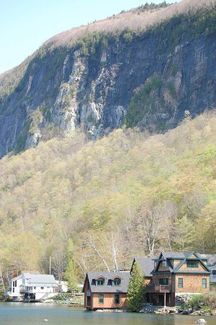
On Friday, May 19 at 4:30 pm, after nearly a week of pre-planning, members of Stowe Mountain Rescue, Colchester Technical Rescue and the Vermont National Guard Mountain Warfare Unit, successfully recovered the body of a man who had been missing on Mt. Pisgah. The body was located on a sloping ledge with large amounts of loose unstable rock approximately 350' below an overlook and hundreds of feet above the waters of Lake Willoughby.
Rescuers had to navigate down a slippery Class III / IV buttress in order to find an appropriate spot to access the subject. A two-tensioned rope rescue system was used to lower rescuers 100' onto the ledge at which point two pairs of bolts were placed in order to anchor the rescuers and secure the body for packaging. The conditions included, rain, loose / wet rock and limited visibility. "This is one of the most challenging, and I think technical rescues that we've had to conduct in Vermont," Vermont State Police Search and Rescue coordinator Neil Van Dyke said.
Present at the scene included Peak Rescue alumni Chip Perry (CTR / VT-TF1), Greg Speer (SMR), Todd Westervelt (SMR), and Peak Rescue instructor Matt Speier (CTR / VT-TF1). Other agencies assisting in the recovery efforts included Vermont State Police SAR, Vermont Air National Guard (helicopter), Orleans Rescue, Grand Isle Sheriff's Office (drone), VT Fish & Wildlife . Click here for the WFFF news report.
Rescuers had to navigate down a slippery Class III / IV buttress in order to find an appropriate spot to access the subject. A two-tensioned rope rescue system was used to lower rescuers 100' onto the ledge at which point two pairs of bolts were placed in order to anchor the rescuers and secure the body for packaging. The conditions included, rain, loose / wet rock and limited visibility. "This is one of the most challenging, and I think technical rescues that we've had to conduct in Vermont," Vermont State Police Search and Rescue coordinator Neil Van Dyke said.
Present at the scene included Peak Rescue alumni Chip Perry (CTR / VT-TF1), Greg Speer (SMR), Todd Westervelt (SMR), and Peak Rescue instructor Matt Speier (CTR / VT-TF1). Other agencies assisting in the recovery efforts included Vermont State Police SAR, Vermont Air National Guard (helicopter), Orleans Rescue, Grand Isle Sheriff's Office (drone), VT Fish & Wildlife . Click here for the WFFF news report.
November 20, 2016: Cannon Cliff, Franconia, New Hampshire
Mountain Rescue Service
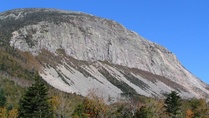
On Saturday, November 20 at 1:30 am, members of Mountain Rescue Service were dispatched to Cannon Cliffs for a report of two climbers stuck on the Moon Shadow climbing route. Cannon Cliff is one of the tallest (1,200') cliffs east of the Mississippi. Only six team members were available for the call including Peak Rescue instructor Paul Cormier. The cliff was accessed via a tram ride to the summit. The team then hiked down to find the top of the climb which was a challenge in the dark. The climbers were located 250' from the top. Two rescuers were sent down and two separate 250' raises were initiated (1 knot pass per raise) in the early morning light. The condition included darkness, rain, 35 degree tems and 40 mph winds. Click here for the WMUR news report.
July 27 - August 2, 2016: Vigilant Guard Catastrophic Emergency Exercise, Colchester, Vermont
Vermont USAR Task Force 1
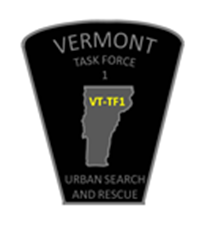
Peak Rescue alumni PJ Aumand (VT-TF1 Logistics Officer), Chip Perry (VT-TF1 Rescue Tech) and 2016 scholarship student Dave Auriemma (VT-TF1 Rescue Tech) participated along side 5000 other emergency responders from all over the US in Vermont's largest ever emergency exercise. The exercise played out in multiple locations across the state and simulated a major earthquake affecting numerous locations over the course of a week. Various scenarios were created including locating victims amidst a large debris pile simulating a structural collapse and a mid-face pick off of an individual trapped on a ledge.
Click here for a link t the FEMA website and video report.
Click here for a link t the FEMA website and video report.
May 19, 2016: Drone Aids Puppy Rescue, Gold Hill, Oregon
Jackson County Fire District #3
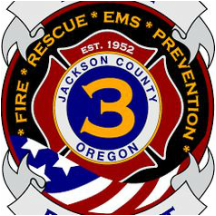
On Wednesday, May 18, 2016, Jackson County Fire District 3 responded to a report of a 50 pound Bullmastiff that had fallen 40 feet onto a rocky beach near the Powerhouse Rapids on the Rogue River. According to Battalion Chief (and Peak Rescue Instructor) Mike Calhoun, this was the first time they had an opportunity to deploy their aerial drone in an actual rescue operation.
The drone was positioned over the Powerhouse Rapids in order to give the firefighters a better vantage point to assess the scene and to visualize the rescuers who rappelled down to the fallen puppy. A two-tensioned rope system was rigged and the uninjured dog was hauled back up the cliff face.
Click here for the news report.
The drone was positioned over the Powerhouse Rapids in order to give the firefighters a better vantage point to assess the scene and to visualize the rescuers who rappelled down to the fallen puppy. A two-tensioned rope system was rigged and the uninjured dog was hauled back up the cliff face.
Click here for the news report.
March 14, 2016: Tuckerman's Ravine, New Hampshire
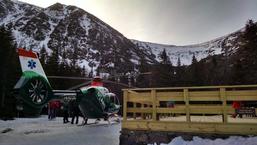
On Sunday, March 14, 2016, weather on Mount Washington was in the high 20’s (F) with bright sunshine and moderate northwest winds. Rain the previous week had saturated the snowpack which later refroze during the night when temperatures dropped to the mid-teens. By late morning, sun began to soften the snow, making for good skiing and snow climbing conditions in areas facing the sun. Unusually warm and dry conditions have predominated this winter, leaving many boulders and ice cliffs exposed which are usually buried by many feet of snow and avalanche debris at this time of year.
(Photo: Courtesy of Sam Bendroth)
At approximately 3:00 p.m., a party of six skiers descended a 2,000-foot long 30-40 degree snow gully named Hillman’s Highway in Tuckerman Ravine. One of the six expert skiers slipped and fell part of the way down. Due to the icy nature of the slope, he was unable to arrest his fall which took him 700 -900’ down the slope over patches of ice, boulders, and at least one low angle ice and rock buttress. U.S. Forest Service Avalanche Center staff, Mount Washington Volunteer Ski Patrollers, an AMC Caretaker and several guides working in the area responded to render first aid and evacuate the patient. Amongst the responders was U.S. Forest Service Snow Ranger and Peak Rescue Institute Instructor Frank Carus. The crew performed a series of roped litter lowers to bring the man the remaining distance down the steep slope. Due the nature of the man’s injuries and calm weather conditions, a DHART helicopter was used to medivac the patient.
At approximately 5:30 p.m., Gorham Police Dispatch called U.S. Forest Service Snow Rangers to report a request for help for an injured climber near the summit of Washington on the Tuckerman Ravine trail. A rescue team was again dispatched to locate the party. Simultaneously, a team of NH Fish and Game officers, Mountain Rescue Service members, and NH State Park personnel used the Mount Washington Auto Road to approach the east snowfields in attempt to locate and evacuate the patient before dark. Given the nature of the injuries and time of day, DHART was once again to fly out the patient. The patient was located at about 6:45 p.m. Due to flight regulations, the first DHART flight crew returned to base before the small rescue team could move the patient through difficult terrain to the landing zone. A fresh DHART crew arrived at the landing zone and the patient was transferred to Dartmouth-Hitchcock Hospital just before 10:00 p.m.
Click here for the news report.
(Photo: Courtesy of Sam Bendroth)
At approximately 3:00 p.m., a party of six skiers descended a 2,000-foot long 30-40 degree snow gully named Hillman’s Highway in Tuckerman Ravine. One of the six expert skiers slipped and fell part of the way down. Due to the icy nature of the slope, he was unable to arrest his fall which took him 700 -900’ down the slope over patches of ice, boulders, and at least one low angle ice and rock buttress. U.S. Forest Service Avalanche Center staff, Mount Washington Volunteer Ski Patrollers, an AMC Caretaker and several guides working in the area responded to render first aid and evacuate the patient. Amongst the responders was U.S. Forest Service Snow Ranger and Peak Rescue Institute Instructor Frank Carus. The crew performed a series of roped litter lowers to bring the man the remaining distance down the steep slope. Due the nature of the man’s injuries and calm weather conditions, a DHART helicopter was used to medivac the patient.
At approximately 5:30 p.m., Gorham Police Dispatch called U.S. Forest Service Snow Rangers to report a request for help for an injured climber near the summit of Washington on the Tuckerman Ravine trail. A rescue team was again dispatched to locate the party. Simultaneously, a team of NH Fish and Game officers, Mountain Rescue Service members, and NH State Park personnel used the Mount Washington Auto Road to approach the east snowfields in attempt to locate and evacuate the patient before dark. Given the nature of the injuries and time of day, DHART was once again to fly out the patient. The patient was located at about 6:45 p.m. Due to flight regulations, the first DHART flight crew returned to base before the small rescue team could move the patient through difficult terrain to the landing zone. A fresh DHART crew arrived at the landing zone and the patient was transferred to Dartmouth-Hitchcock Hospital just before 10:00 p.m.
Click here for the news report.
February 18, 2016: Joint Base Lewis-McChord, Washington
THURSTON County SPECIAL Operations Rescue Team
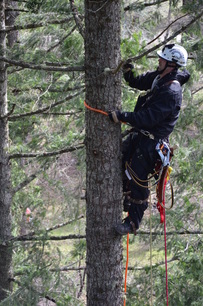
On February 18th while in the middle of a complex confined space rescue drill the Thurston County Special Operations Rescue Team was dispatched to Joint Base Lewis McCord for a report of military serviceman stuck in a tree from a low altitude parachute jump. The team broke away their tree rescue techs and responded to the call with R91, SORT 34 and B91. Lacey Fire Trk 31 and SE Thurston Fire Authority Engine 24 were already enroute and arrived on scene first. Military personnel met the responders and led them to the site.
Upon arrival on scene they found a special forces specialist over 100' up in a fir tree stranded on a limb attached to his chute. He was uninjured.The chute was tangled in the branches. Engine 24 deployed a 24' extension ladder due to the large diameter of the tree at the base. A rescue climber was deployed to climb the tree using spurs,a flip line and a split tail. A back up climber suited up and an experienced rescuer climber climbed a nearby tree to monitor progress and function as an aerial safety.
The rescue climber secured the stranded specialist to the tree and disconnected the parachute from the harness. The specialist was lowered on a Petzl RIG with a Munter hitch belay. After the specialist was on the ground the rescue climber assisted military personnel with removing the parachute from the tree.
Peak Rescue personnel on scene were:
IC. Andy Speier, PRI Instructor
RGS Scott Santhuff, PRI Specialist
TR Safety Jon Kalar, PRI Specialist
Observer and Aerial Safety Ryan Cox, PRI Technician
Departments on scene: McLane-Black Lake Fire, Olympia Fire, Lacey Fire, Tumwater, SE Thurston Fire Authority, JBLM Fire, JBLM EMS.
Upon arrival on scene they found a special forces specialist over 100' up in a fir tree stranded on a limb attached to his chute. He was uninjured.The chute was tangled in the branches. Engine 24 deployed a 24' extension ladder due to the large diameter of the tree at the base. A rescue climber was deployed to climb the tree using spurs,a flip line and a split tail. A back up climber suited up and an experienced rescuer climber climbed a nearby tree to monitor progress and function as an aerial safety.
The rescue climber secured the stranded specialist to the tree and disconnected the parachute from the harness. The specialist was lowered on a Petzl RIG with a Munter hitch belay. After the specialist was on the ground the rescue climber assisted military personnel with removing the parachute from the tree.
Peak Rescue personnel on scene were:
IC. Andy Speier, PRI Instructor
RGS Scott Santhuff, PRI Specialist
TR Safety Jon Kalar, PRI Specialist
Observer and Aerial Safety Ryan Cox, PRI Technician
Departments on scene: McLane-Black Lake Fire, Olympia Fire, Lacey Fire, Tumwater, SE Thurston Fire Authority, JBLM Fire, JBLM EMS.
february 28, 2016: Cliff Rescue, Sunset Cliffs, San Diego, California

On Sunday, February 28, 2016, Peak Rescue instructors Ben Lewis and Jon Vipond and Peak Graduate Ric Stell responded with a team of Lifeguards and Firefighters to a report of a fall with injuries at Sunset Cliffs in San Diego, CA. The patient had reportedly attempted to access the beach in a hazardous area to retrieve a remote control glider. A lifeguard paramedic and a firefighter paramedic were lowered down the cliff where they determined the patient to be a major trauma. A Fire-Rescue helicopter was dispatched and the patient was airlifted to the hospital.
Click here for video of the patient taking the fall and here for a couple of pictures.
Click here for video of the patient taking the fall and here for a couple of pictures.
January 31, 2016: Fallen Ice Climber Rescued, Mt Willard, New Hampshire
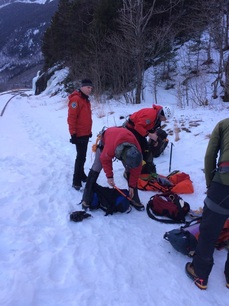
On Sunday, January 31, Peak Rescue instructor Frank Carus responded to a report of an ice climber who fell while climbing Upper Hitchcock Gully on Mt. Willard, NH. Also on scene were Peak Rescue graduates Paul Cormier (Mountain Rescue Service) and Lt. Brad Morse (NH Fish and Game). Nearby ice climbers assisted the climbing party in lowering the injured climber down the steepest 2 pitches of the NEI 3, M3, 1000' alpine-like gully before rescue personnel arrived at the scene with a litter at approximately 1700. After assessing and packaging the patient, crews lowered the injured climber the remaining 3 pitches of mixed ice and rock. The mission was complicated by a period of sustained warm temperatures which led to loose rocks in the gully. Personnel cleared the scene at 1930. Other agencies involved included Androscoggin Valley Search & Rescue and Bartlett Jackson Ambulance, they participated in the rescue.
For additional information click here .
For additional information click here .
January 24, 2016: Injured Hiker Rescued at Nooksack Falls, Bellingham, Washington
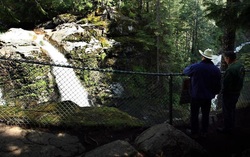
On Sunday, January 24, former Peak Rescue instructor Jarod Trow was working as a FF/Paramedic with Bellingham FD Medic One when they were dispatched to assist Whatcom County Fire District 19 with the report of a hiker who had fallen approximately 75 feet from a cliff near Nooksack Falls. The patient was initially reported as unresponsive. Jarod took on a key role in the rigging of a rope rescue system to help extricate the patient. Per Whatcom County Chief Jerry DeBruin, Jarod's experience in technical rescue "just added a whole other level of expertise". Members of Whatcom County Search and Rescue were also on scene.
For additional information click here.
For additional information click here.
January 17, 2016: Avalanche in the Chute - Tuckerman's Ravine, New Hampshire
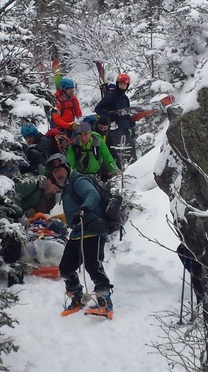
On Monday, January 18, two of Peak Rescue's instructors, Mike Lackman and Frank Carus, were on scene to effect a rescue of climbers caught in an avalanche. Mike and Eastern Mountain Sports Climbing School Guide David Lottman were on the last day of teaching a three day American Institute of Avalanche Research & Education course in Tuckerman's Ravine. While approaching an area known as The Chute a climber in another party triggered an avalanche that caught and carried 5 climbers 800 feet down a 45 degree slope only a few feet a way from their class. It was at this time that David and Mike became actively involved in the rescue of the injured climbers. Frank Carus is a US Forest Service Snow Ranger stationed in Tuckerman's Ravine and he was also on the scene and participated in the extrication of the injured party.
Click here for the Mt. Washington Avalanche Center's analysis of the avalanches.
Click here for the Mt. Washington Avalanche Center's analysis of the avalanches.
October 17, 2015: Dist. 3 Tech Rescue Team Rescues 2 at Flounce Rock d, Prospect, Oregon
JACKSON COUNTY FIRE DISTRICT #3
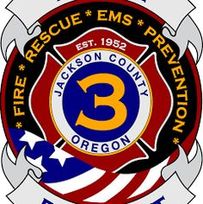
On Saturday, October 17 at 1:12 a.m. a caller contacted 9-1-1 and stated that he was on top of Flounce Rock Rd and a member of his group had stepped out of the vehicle and stumbled off of a cliff. He had made his way down to the victim and she was breathing normal but was in extreme pain.At 1:58 a.m. the male in the group called 9-1-1 again stating that his truck had rolled down the cliff approximately 70ft. He was unsure if the third person in his group was inside when it rolled. It was later discovered that the third person was in fact in the vehicle at the time of the roll and sustained injuries.
Jackson County Fire District 3 Technical Rescue Team (including former Peak Rescue student FF Steve Ede and Peak Rescue instructor Engineer Javier Lopez), Prospect Fire Department and Mercy Flights responded to the incident. While in route, crews received information that the victim had fallen 60ft and could possibly have a broken back. Upon arrival, crews found the terrain to be dark and rugged, posing a challenge. Close to 20 emergency personnel responded to the incident.
At 3:59 a.m. the High Angle Rescue Team began the decent over the edge to rescue the first fall victim. Crews worked quickly to stabilize the victim and bring her back to safety. At 5:05 a.m. crews were able to get the patient to medical care.
Crews then began work on the second victim who had fallen when the vehicle’s clutch was accidently released. The victim was recovered with moderate injuries and taken to the hospital at 6:00 a.m.
Jackson County Fire District 3 Technical Rescue Team (including former Peak Rescue student FF Steve Ede and Peak Rescue instructor Engineer Javier Lopez), Prospect Fire Department and Mercy Flights responded to the incident. While in route, crews received information that the victim had fallen 60ft and could possibly have a broken back. Upon arrival, crews found the terrain to be dark and rugged, posing a challenge. Close to 20 emergency personnel responded to the incident.
At 3:59 a.m. the High Angle Rescue Team began the decent over the edge to rescue the first fall victim. Crews worked quickly to stabilize the victim and bring her back to safety. At 5:05 a.m. crews were able to get the patient to medical care.
Crews then began work on the second victim who had fallen when the vehicle’s clutch was accidently released. The victim was recovered with moderate injuries and taken to the hospital at 6:00 a.m.
October 5, 2015: Amtrak Train Derailment, Northfield, Vermont
Colchester Technical Rescue / Vermont USAR Task Force 1
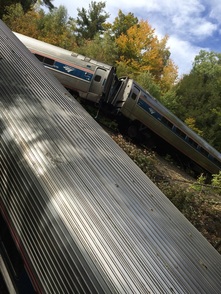
On Monday, October 5 at 1112 members of Colchester Technical Rescue (CTR) were dispatched to Northfield, Vermont for a report of an Amtrak passenger train derailment that occurred just before 1030 after hitting a rock slide lying on the tracks.
The initial report stated that five of the six cars had left the track and that two of them, including the locomotive, had gone over an embankment and were in a brook. The train carried 98 passengers and 4 crew members all of which had been removed from the scene prior to the team's arrival.
Once on scene we noted the locomotive laying on it's side leaking diesel fuel at the bottom of an embankment just above a brook. The number two car was perpendicular to the tracks pointed down the embankment and listing to the right. It was reported that no passengers had boarded that car. The number three car sustained damage and had left the track and was listing toward the embankment. The last car was still on the track while all other cars were upright but derailed.
We were tasked with entering the number two car that was pointed down the embankment to confirm that there was nobody inside. With the available equipment on scene it was not possible to further secure the 165,000 pound car. Portions of the car that were in contact with the ground were marked with paint in order to check for movement. One of the CTR rescue techs rappelled into the car, made a final search and then ascended back out without incident.
The team was then redirected to rappel down the embankment to search the inside of the locomotive as well as the surrounding area. Four of CTR's techs gained access via ropes anchored to the tracks above. Significant amounts of diesel fuel kept the techs from entering the locomotive however they were able to visualize that the compartments were clear and were informed that the crew had been accounted for.
Miraculously, of the 102 people on board, six people including one crew member, were transported to the local hospital with non life-threatening injuries and another crew member was airlifted to a Level 1 trauma center with serious injuries. Quick response by local emergency crews contributed to a positive outcome.
Present at the scene included former Peak Rescue students Justin Bliss (CTR / South Burlington FD - 2014 Scholarship recipient), Dieter Mulac (CTR / Burlington FD), Chip Perry (CTR / 2015 Scholarship recipient) and P.J. Aumand (MA TF1 / CTR / BFD - 2015 Scholarship recipient) and Peak Rescue instructor Matt Speier (CTR).
Other responding agencies included VT USAR TF1, Burlington FD, Hartford FD, Northfield Ambulance, Roxbury FD, Barre FD, Williamstown FD, Berlin FD, Montpelier FD, Northfield PD, Amtrak PD, Vermont State Police Mobile Command Center and Vermont State HazMat Response Team.
The initial report stated that five of the six cars had left the track and that two of them, including the locomotive, had gone over an embankment and were in a brook. The train carried 98 passengers and 4 crew members all of which had been removed from the scene prior to the team's arrival.
Once on scene we noted the locomotive laying on it's side leaking diesel fuel at the bottom of an embankment just above a brook. The number two car was perpendicular to the tracks pointed down the embankment and listing to the right. It was reported that no passengers had boarded that car. The number three car sustained damage and had left the track and was listing toward the embankment. The last car was still on the track while all other cars were upright but derailed.
We were tasked with entering the number two car that was pointed down the embankment to confirm that there was nobody inside. With the available equipment on scene it was not possible to further secure the 165,000 pound car. Portions of the car that were in contact with the ground were marked with paint in order to check for movement. One of the CTR rescue techs rappelled into the car, made a final search and then ascended back out without incident.
The team was then redirected to rappel down the embankment to search the inside of the locomotive as well as the surrounding area. Four of CTR's techs gained access via ropes anchored to the tracks above. Significant amounts of diesel fuel kept the techs from entering the locomotive however they were able to visualize that the compartments were clear and were informed that the crew had been accounted for.
Miraculously, of the 102 people on board, six people including one crew member, were transported to the local hospital with non life-threatening injuries and another crew member was airlifted to a Level 1 trauma center with serious injuries. Quick response by local emergency crews contributed to a positive outcome.
Present at the scene included former Peak Rescue students Justin Bliss (CTR / South Burlington FD - 2014 Scholarship recipient), Dieter Mulac (CTR / Burlington FD), Chip Perry (CTR / 2015 Scholarship recipient) and P.J. Aumand (MA TF1 / CTR / BFD - 2015 Scholarship recipient) and Peak Rescue instructor Matt Speier (CTR).
Other responding agencies included VT USAR TF1, Burlington FD, Hartford FD, Northfield Ambulance, Roxbury FD, Barre FD, Williamstown FD, Berlin FD, Montpelier FD, Northfield PD, Amtrak PD, Vermont State Police Mobile Command Center and Vermont State HazMat Response Team.
July 5, 2015: Huntington Gorge, Richmond, Vermont
Colchester Technical Rescue / Stowe Mountain Rescue
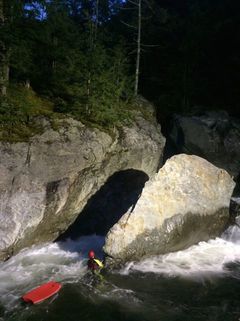
On Sunday, July 5 at 1810 members of Colchester Technical Rescue (CTR) and Stowe Mountain Rescue (SMR) were dispatched to the Huntington Gorge in Richmond, Vermont for a report of "a female who had fallen in - CPR in progress - unsure if still in the gorge or out".
Upon arrival at the scene we learned that a 22 year old woman along with two males slipped and fell into swift water at the gorge. One of the males fell in attempting to rescue the other two. The two males were able to free themselves however the female was caught in a strainer and drowned. At some point one of the males had become unresponsive and CPR may (or may not) have been initiated. He was transported to the hospital by Richmond Rescue with non-life threatening injuries.
The female was located just prior to our arrival. She was caught in debris river right between the rock wall and the upstream edge of the large slab (which actually separated from the wall during Hurricane Irene).
Access involved rappelling over a 15' rock face down to a 10' wide slot of fast moving white water. Difficult conditions including high water levels due to very heavy recent rainfall and imminent darkness created an unsafe environment for the rescuers. The State hydrologist was contacted. It was his belief that water levels would likely drop the following morning. With that information a decision was made to return to the site early in the morning to perform a recovery.
The recovery involved sending two rescuers over the edge to access the victim. Tandem mirrored systems with MPDs were utilized. A heavy duty tow truck was on standby at the scene to potentially be used to remove debris from around the victim. Swiftwater trained personnel were placed down river as safety. The victim was freed, secured and moved to the shoreline for packaging.
Present at the scene included former Peak Rescue students Justin Bliss (CTR), Dieter Mulac (CTR), Greg Speer (SMR), Doug Veliko (SMR) and 2015 Scholarship recipients Chip Perry (CTR) and P.J. Aumand (MA TF1 / CTR) as well as Peak Rescue instructor Matt Speier.
The Huntington Gorge is a notorious site that has claimed 26 lives including that of a Vermont State Police rescue diver. That tragic accident occurred in 1992 during another body recovery.
Other responding agencies included Richmond Rescue, Richmond FD, Bolton FD, Richmond PD, Vermont State Police.
Here are some links to the news reports with additional pictures and video:
http://www.wcax.com/story/29478815/body-of-milton-woman-recovered-at-huntington-gorge
http://www.burlingtonfreepress.com/picture-gallery/news/2015/07/06/drowning-victim-retrieved-from-huntington-gorge/29771753/
Upon arrival at the scene we learned that a 22 year old woman along with two males slipped and fell into swift water at the gorge. One of the males fell in attempting to rescue the other two. The two males were able to free themselves however the female was caught in a strainer and drowned. At some point one of the males had become unresponsive and CPR may (or may not) have been initiated. He was transported to the hospital by Richmond Rescue with non-life threatening injuries.
The female was located just prior to our arrival. She was caught in debris river right between the rock wall and the upstream edge of the large slab (which actually separated from the wall during Hurricane Irene).
Access involved rappelling over a 15' rock face down to a 10' wide slot of fast moving white water. Difficult conditions including high water levels due to very heavy recent rainfall and imminent darkness created an unsafe environment for the rescuers. The State hydrologist was contacted. It was his belief that water levels would likely drop the following morning. With that information a decision was made to return to the site early in the morning to perform a recovery.
The recovery involved sending two rescuers over the edge to access the victim. Tandem mirrored systems with MPDs were utilized. A heavy duty tow truck was on standby at the scene to potentially be used to remove debris from around the victim. Swiftwater trained personnel were placed down river as safety. The victim was freed, secured and moved to the shoreline for packaging.
Present at the scene included former Peak Rescue students Justin Bliss (CTR), Dieter Mulac (CTR), Greg Speer (SMR), Doug Veliko (SMR) and 2015 Scholarship recipients Chip Perry (CTR) and P.J. Aumand (MA TF1 / CTR) as well as Peak Rescue instructor Matt Speier.
The Huntington Gorge is a notorious site that has claimed 26 lives including that of a Vermont State Police rescue diver. That tragic accident occurred in 1992 during another body recovery.
Other responding agencies included Richmond Rescue, Richmond FD, Bolton FD, Richmond PD, Vermont State Police.
Here are some links to the news reports with additional pictures and video:
http://www.wcax.com/story/29478815/body-of-milton-woman-recovered-at-huntington-gorge
http://www.burlingtonfreepress.com/picture-gallery/news/2015/07/06/drowning-victim-retrieved-from-huntington-gorge/29771753/
April 17, 2015: Lacey, Washington
Thurston County Special Operations Rescue Team
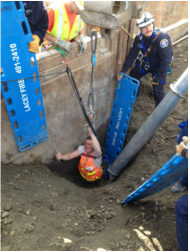
PRI Instructors Andy Speier, Jon Kalar and graduates Ryan Cox, Crystal Murphy and Scott Santuff responded to Lacey, WA for a trench rescue operation. Responding as members of the Thurston County Special Operations Rescue Team (SORT) they accessed and rescued the trapped construction worker. Also on scene were units from Lacey Fire District 3.
News report
POST INCIDENT REPORT:
Lacey Fire District 3 (WA) and the Thurston County Special Operations Rescue Team (SORT) responded to a trench rescue at the site of an excavation. Workers had been doing excavation work for installing below ground fuel tanks. A large trench box was in use. One of the workers had been walking along the outside of the box when he began to sink into an ever widening hole.
The initial dispatch was for a BLS response for a fall. Soon after the engine company responded on the air the dispatcher gave the officer additional information. The engine officer called for additional resources including a rescue response from the SORT. Upon arrival of the first due engine they found a man buried up to his chest with his arms raised over his head holding onto the hook of an excavator trucks boom. The area was filled with construction workers attempting to dig their buddy out. The engine company officer was unable to get the construction workers out the hole. His crew began to assist with moving dirt.
Upon arrival of the shift Battalion Chief he assumed command from the initial arriving engine and assigned a rescue technician on his shift as the Rescue Group Supervisor and assigned the department training officer as the Safety Officer. Within 15-20 minutes the Technical Rescue Units arrived, a TR Safety was assigned and equipment began to move to the site.
All engine company personnel were rotated out of the hazard zone and replaced by rescue techs wearing class III harnesses. At this point two construction workers refused to leave the trench. A victim harness was applied to the victim but the leg loops were not able to be used until additional dirt was removed to access the victim's inner thighs. Two of the construction workers were physically removed from the area by Police Officers and one was subsequently arrested for pushing one of the officers. The presence of the workers in the hazard zone made it difficult to get specific tasks performed as they were in the way. The initial hazard was that the victim was sliding further into the hole and was supporting himself by his arms. There was no place to shore initially until the victim was exposed. The plan was to get the harness properly secured so that the victim did not need to support himself with his arms reaching above. A vactor truck arrived on scene and initially it was thought that the excavator would need to move so that they could get the vactor truck in place. The victim then would have to let go of the hook hanging over his head. He could not do this as he was stopping himself from sinking further into the hole. A set of fours was used to support him and attached to a roof ladder rung that was above the victim. The excavator operator would not move the machine as he was talking with one of his associates that was still digging and refused to get out of the trench. This became frustrating for the rescuers trying to coordinate the placement of the vactor truck. The public works vactor truck was positioned opposite from the original location and was used to remove soil from around the victim. One of the leg loops was able to be attached and with the waist belt held down the victim was able to free his hands and was able to assist with digging around himself to a point where he was able to pull himself free. As he freed himself and scrambled onto the top of the trench box the ground pads were being passed down to the site.
The victim was evaluated by fire department medics at the scene but he refused to go to the hospital and signed a release.
Operating on scene were 2 Engines, 2 Trucks, 2 Battalions, 2 Technical Rescue Units, 1 Medic Unit, 1 Ambulance, 3 Staff Officers. Participating agencies were from:
Lacey Fire District #3
Olympia Fire Department
McLane-Black Lake Fire Department
East Olympia Fire Department
Lacey Police Department
Lacey Public Works
Reported by: Andy Speier, Batt. Chief of Special Operations
McLane-Black Lake Fire Department
Olympia WA
News report
POST INCIDENT REPORT:
Lacey Fire District 3 (WA) and the Thurston County Special Operations Rescue Team (SORT) responded to a trench rescue at the site of an excavation. Workers had been doing excavation work for installing below ground fuel tanks. A large trench box was in use. One of the workers had been walking along the outside of the box when he began to sink into an ever widening hole.
The initial dispatch was for a BLS response for a fall. Soon after the engine company responded on the air the dispatcher gave the officer additional information. The engine officer called for additional resources including a rescue response from the SORT. Upon arrival of the first due engine they found a man buried up to his chest with his arms raised over his head holding onto the hook of an excavator trucks boom. The area was filled with construction workers attempting to dig their buddy out. The engine company officer was unable to get the construction workers out the hole. His crew began to assist with moving dirt.
Upon arrival of the shift Battalion Chief he assumed command from the initial arriving engine and assigned a rescue technician on his shift as the Rescue Group Supervisor and assigned the department training officer as the Safety Officer. Within 15-20 minutes the Technical Rescue Units arrived, a TR Safety was assigned and equipment began to move to the site.
All engine company personnel were rotated out of the hazard zone and replaced by rescue techs wearing class III harnesses. At this point two construction workers refused to leave the trench. A victim harness was applied to the victim but the leg loops were not able to be used until additional dirt was removed to access the victim's inner thighs. Two of the construction workers were physically removed from the area by Police Officers and one was subsequently arrested for pushing one of the officers. The presence of the workers in the hazard zone made it difficult to get specific tasks performed as they were in the way. The initial hazard was that the victim was sliding further into the hole and was supporting himself by his arms. There was no place to shore initially until the victim was exposed. The plan was to get the harness properly secured so that the victim did not need to support himself with his arms reaching above. A vactor truck arrived on scene and initially it was thought that the excavator would need to move so that they could get the vactor truck in place. The victim then would have to let go of the hook hanging over his head. He could not do this as he was stopping himself from sinking further into the hole. A set of fours was used to support him and attached to a roof ladder rung that was above the victim. The excavator operator would not move the machine as he was talking with one of his associates that was still digging and refused to get out of the trench. This became frustrating for the rescuers trying to coordinate the placement of the vactor truck. The public works vactor truck was positioned opposite from the original location and was used to remove soil from around the victim. One of the leg loops was able to be attached and with the waist belt held down the victim was able to free his hands and was able to assist with digging around himself to a point where he was able to pull himself free. As he freed himself and scrambled onto the top of the trench box the ground pads were being passed down to the site.
The victim was evaluated by fire department medics at the scene but he refused to go to the hospital and signed a release.
Operating on scene were 2 Engines, 2 Trucks, 2 Battalions, 2 Technical Rescue Units, 1 Medic Unit, 1 Ambulance, 3 Staff Officers. Participating agencies were from:
Lacey Fire District #3
Olympia Fire Department
McLane-Black Lake Fire Department
East Olympia Fire Department
Lacey Police Department
Lacey Public Works
Reported by: Andy Speier, Batt. Chief of Special Operations
McLane-Black Lake Fire Department
Olympia WA
April 1, 2015: Joint Base Lewis-McChord, Washington
THURSTON COUNTY SPECIAL OPERATIONS RESCUE TEAM
PRI Instructor Jon Kalar and graduates Chris Barney, Ryan Cox, Crystal Murphy, Casey Sobol and Scott Santuff responded to Joint Base Lewis McChord for an Airborne Ranger from the 2nd Ranger Battalion stuck in a tree after a jump. Responding as members of the Thurston County Special Operations Rescue Team (SORT) they accessed and rescued the stranded Ranger.
The victim was hanging between two trees suspended 70' off the ground. Due to the terrain an aerial ladder was not able to access the site. Kalar and Santuff (Scott has been one of the climbers on nearly all tree rescues to date) each climbed a tree, two other climbers were left on the ground as RIT. Sobol assumed Command and Cox was the Rescue Group Supervisor. Barney coordinated rigging on the ground. Santuff was able to climb slightly above the victim and get a mainline out to him. With specific instructions from Santuff and Kalar the victim attached the mainline to his pararchute harness rings and was hauled with a set of fours over to the tree that Santuff was in. He was lowered to the ground using an I'd. Once on the ground a JBLM Medic checked out the Ranger and he was released at the scene. Santuff rappelled out of the tree using a split tail and the I'd. Kalar was lowered with an MPD. No equipment was left in the tree and there were no injuries. From time on scene until the patient was on the ground was approx. 90 minutes.
Other units on scene were Engine 24 and a BC, Engine and Rescue from JBLM Fire Department
The victim was hanging between two trees suspended 70' off the ground. Due to the terrain an aerial ladder was not able to access the site. Kalar and Santuff (Scott has been one of the climbers on nearly all tree rescues to date) each climbed a tree, two other climbers were left on the ground as RIT. Sobol assumed Command and Cox was the Rescue Group Supervisor. Barney coordinated rigging on the ground. Santuff was able to climb slightly above the victim and get a mainline out to him. With specific instructions from Santuff and Kalar the victim attached the mainline to his pararchute harness rings and was hauled with a set of fours over to the tree that Santuff was in. He was lowered to the ground using an I'd. Once on the ground a JBLM Medic checked out the Ranger and he was released at the scene. Santuff rappelled out of the tree using a split tail and the I'd. Kalar was lowered with an MPD. No equipment was left in the tree and there were no injuries. From time on scene until the patient was on the ground was approx. 90 minutes.
Other units on scene were Engine 24 and a BC, Engine and Rescue from JBLM Fire Department
March 14, 2015: Touvelle State Recreation Site, Central Point, Oregon
Jackson County Fire District #3
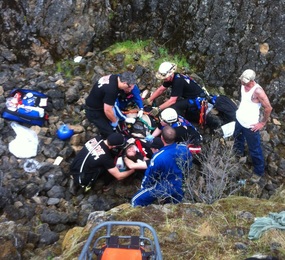
Here is a shot of our team, along with duty crew members, conducting a rescue of a female fall victim. She fell approximately 20 feet while downclimbing (in flip flops) over the side of the Upper Table Rock in my District. Pictured are many Peak grads. Once access was made, a class 3 carry out to the top of the rock (with a very short class 4 transition over the edge) to the awaiting helo for transport to the hospital. Injuries were a suspected fractured pelvis and altered LOC. She'll live to climb another day.
Capt. Mike Calhoun
KDRV new story
Capt. Mike Calhoun
KDRV new story
Winter 2015: Mountain Rescue Association Newsletter
Meridian - The Quarterly Publication of the MRA
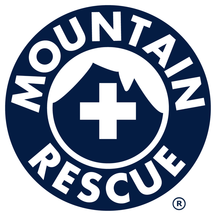
The Winter 2015 edition of the MRA's Meridian publication features a thank you note from Dave Clark, MRA President (p. 10). Dave was a student in the 2014 Specialist level course. In addition, there is an article written by Andy Speier (p. 9) that looks back at Peak's involvement in the June 2014 SARCON (MRA / NASAR Spring Conference).
Click here and then scroll down to page 9.
Click here and then scroll down to page 9.
September 28, 2014: Smugglers Notch, Vermont
Stowe Mtn. Rescue / Colchester Technical Rescue
Members of Stowe Mtn. Rescue and Colchester Technical Rescue worked together to access and evacuate a woman who fell 15 feet while descending Hidden Gully. The woman sustained a lower leg fracture. Her leg was immobilized with a splint, a vacuum mattress and was administered pain meds. The team made use of a rope system with belay line to lower the woman about 200 feet over class 4 terrain with three attendants attached to the litter to facilitate the evacuation.
June 29, 2014: Huntington Gorge, Richmond, Vermont
Colchester Technical Rescue / Stowe Mtn. Rescue
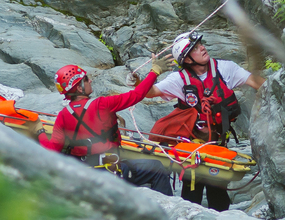
Multiple crews responded to the Huntington Gorge around 3:30 Sunday afternoon after police say a witness spotted a shirt, and what appeared to be hair, stuck under branches in the water. Members of Colchester Technical Rescue and Stowe Mountain Rescue rappelled down the rocks to the water where the shirt was spotted. The body was removed from the water Sunday evening. She is described as a white woman in her mid 30's to late 40's. Police are still working to identify her. At this time, we do not know how the victim ended up in they water. The Huntington Gorge is a popular swimming spot, but it's also extremely deadly. More than 20 people have drowned there since 1950.
Burlington Free Press story
WCAX follow up story
(Photo: Ryan Mercer/Free Press)
Burlington Free Press story
WCAX follow up story
(Photo: Ryan Mercer/Free Press)
May 27, 2014: Winooski River, S. Burlington, Vermont
South Burlington Fire Dept. / Colchester Technical Rescue
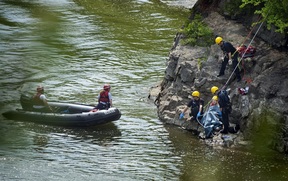
Rescue crews from South Burlington Fire Department and Colchester Technical Rescue safely pulled a man from the Winooski River Tuesday afternoon. South Burlington Fire Chief Douglas Brent says the man fell on the way to the river and was clinging to the rocks. The man wasn't seriously hurt. "We were able to stabilize him," Brent said. "We mapped out a couple of ways to get him out, one being a boat and the second being a vertical lift out of the gorge. The easier of the two ending up being the boat." The man's condition is not known, but he was sent to the hospital.
ABC 22 News Report
(Photo: Glenn Russell/Free Press)
ABC 22 News Report
(Photo: Glenn Russell/Free Press)
May 15, 2014: Camel's Hump State Park, Vermont
Waterbury Backountry Rescue / Stowe Mtn. Rescue / Colchester Technical Rescue
Waterbury Backcountry Rescue requested assistance with a woman who had fallen and injured her hip on the Monroe Trail on Camels Hump. Veliko and Govoni were sent up to locate the subject, evaluate her injuries and stabilize her. A larger team comprised of Waterbury Backcountry, Colchester Technical Rescue and SMR transported the litter and additional medical equipment up the Monroe Trail. The patient was located at approximately 3350' on the Monroe trail, roughly 2.7 miles from the parking lot. She was moved onto a litter and was made comfortable before being transported down to the parking lot. All crew and the patient arrived at the parking lot around midnight.
WCAX story
WCAX story
January 15, 2013: Man Rescued from Well, thurston Cty, Washington
Thurston Cty. Special Ops Rescue Team / Mason Cty. F.D. #4 / Olympia F.D. / Tumwater F.D.
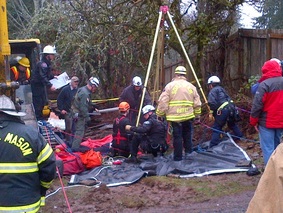
Members of the Thurston County Special Operations Rescue Team (SORT) assisted Mason County Fire District #4 in the rescue of a man that had fallen into an abandoned well at a residence located in the 300 block of SE Arcadia Road near Shelton. According to Andy Speier, Battalion Chief with the McLane Black Lake Fire Department, the man was in the process of demolishing a shed and was standing on what he believed was a four foot deep sump when the earth gave way, plunging him 35 feet down the well into deep water. First responders from Mason County Fire District #4 and the Sheriff’s office were able to successfully lower a floatation device and protective clothing to the man who was treading water to stay afloat. According to Speier, “With the rescue team in place, Lt. Mark Schreck of the Olympia Fire Department was lowered into the well to prepare the victim to be hoisted back to the surface”. “Once secured in a harness, the man was then hauled up and out of the well”. While the patient was wet and cold, he appeared to be uninjured from the fall. Technical rescue trained firefighters from Mclane Black Lake, Olympia, East Olympia, Lacey and Tumwater Fire Departments assisted in the rescue.
